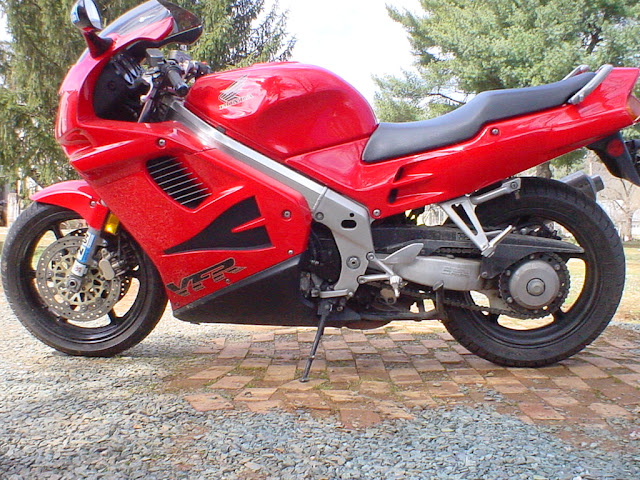Honda VFR750F

This 1989-mode I VFR incorporates the 17- inch front wheel that was introduced in the previous year. The full fairing gave excellent wind protection at speed.
VFR logos were changed to Interceptor for the American market. Whatever its name, the V4 Honda was a brilliantly fast, capable and well balanced superbike.
During the late 1980s and throughout the following decade, the unique and sophisticated VFR750F came to epitomize all that was best about Honda. The VFR. known as the Interceptor in the States, was fast and handled well. Equally importantly it was comfortable, good looking, well equipped and built to a standard that was arguably not matched by any other mass- produced superbike.
Yet ironically the VFR's launch in 1986 had come at a very difficult time for Honda. The firm’s reputation had been hit hard by the unreliability of several models, notably the VF750F whose engine, also a liquid-cooled V4. had proved disastrously unreliable following the bike's introduction three years earlier. The VFR was launched to an unprecedented level of scrutiny. It had to be good, and even more importantly it had to be reliable.
The VFR, created using all Honda’s V4 experience, was both of those things and more. Its 748cc engine retained not only the VF's 90-degree, 16-valve V4 format but also its dimensions of 70 x 48.6mm and even its compression ratio. Like the VF1000R, it turned its camshafts with gears instead of chains, making a positive feature of an area that had been a Honda weakness.
Lighter valves, pistons and conrods helped boost power, as did Keihin CV carburettors that were larger than their VF equivalents, and reangled to provide a straighter intake path. The crankshaft gave a 180- instead of 360-degree firing order, and the lubrication was uprated to cope with a maximum output of I05bhp at I0,500rpm, a gain of I5bhp over the VF750F.
Lightweight frame
The key chassis feature was the new aluminium frame which, in typical Japanese style, combined cast sections at steering head and swingarm pivot with extruded main rails. The frame was stiff and light, helping the VFR weigh a competitive 436lb (I98kg). Suspension and the triple-disc brake system were of excellent quality, too. The forks used air assistance; the rear monoshock could be adjusted for spring preload using a remote knob behind a sidepanel.
As well as impressive top-end power, the engine had plenty of mid-range torque and an engaging V4 character. A twist of the throttle was enough to send the Honda surging smooth!) towards a top speed of over I40mph (225km hi. Crucially, the V4 engine also proved superbh reliable, and the VFR was finished to a notabh high level. The bike’s handling was excellent, too. combining light, precise steering with flawless stability and excellent suspension control.
It added up to a brilliantly balanced superbike that almost single-handedly restored Honda’s reputation for engineering quality. The VFR750 won praise from just about everyone who rode it for its performance and practicality. It was comfortable enough for commuting or touring, yet also fast enough to keep up with its 750cc rivals anywhere other than on a racetrack - and it could be competitive even there, as Honda star Ron Haslam showed with an heroic ride on a near standard VFR in the 1986 Transatlantic Challenge.
When the pressure had been on, Honda had produced one of its finest superbikes. And the VFR was successfully updated in subsequent years, starting in 1988 when it gained a modified fairing and screen, plus a 17- instead of 16-inch front wheel. The VFR750F gradually became slightly sportier without losing its famed all-round ability. Only a few years after the bike’s launch, Honda’s V4 problems were a distant memory, and the initials VFR had come to stand for unmatched versatility and refinement.
Honda VFR750F abilityproblems with previous models meant the VFR s 748cc, liquid-cooled V4 engine was closely scrutinized. A new valve train used gear-driven double overhead camshafts to operate the 16 valves, and helped produce I05bhp with flawless reliability.
Although the VFR could not quite match the agility of more aggressive race-replicas, it was a respectably light bike with a rigid aluminium frame, and handled very well despite suspension that was designed for comfort as much as cornering speed.
Specification Honda VFR750F (1986)
- Engine Liquid-cooled dohe 16-valve 90-degree V4
- Capacity 748cc (70 x 48.6mm)
- Maximum power 105bhp @ 10,500rpm
- Transmission Six-speed, chain final drive
- Frame Aluminium twin spar
- Suspension Telescopic front; single shock rear
- Brakes Twin discs front; disc rear
- Weight 436lb (198kg)
- Top speed 145mph (233km/h)





















0 comments: